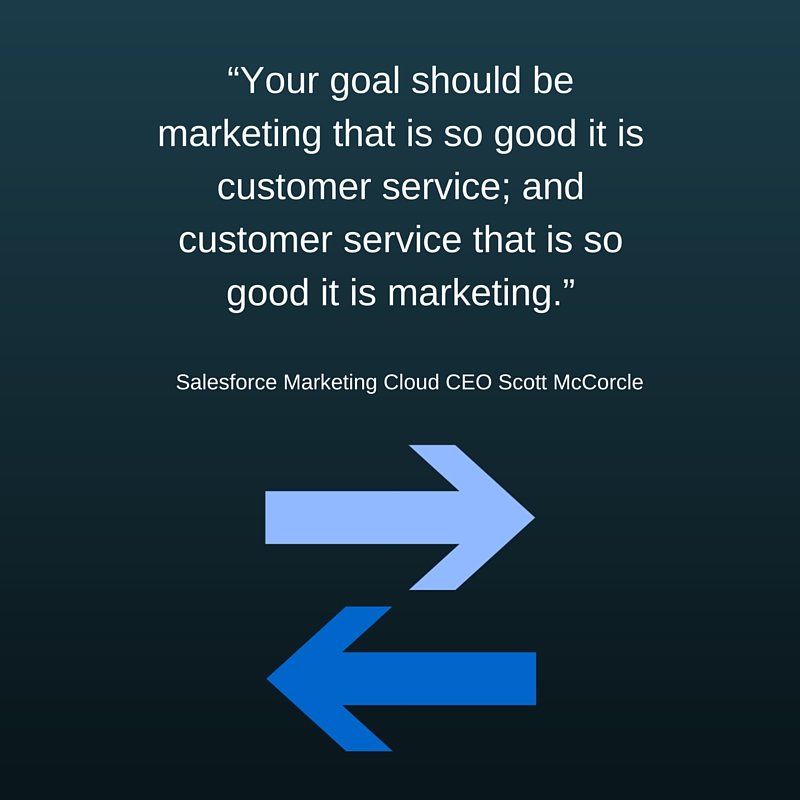
Get your FREE 30-day trial.
Start by selecting a product:
As 2016 gets under way, the role of the Digital Marketer continues to evolve radically as the technology landscape reinvents itself. We’ve written before about the Dawn of the Digital Marketer here. A convergence of spectacular change in the field - such as cloud, big data, and the revolutions in apps, mobile, social and the Internet of things - mean that the way we engage customers is turned upside down.
Recently Graham Dix wrote about the breaking down of barriers between marketing and service while Jeremy Smith wrote about the blurring of lines between customer service and marketing. The relationship with the customer is no longer linear and transactional but a circular continuum and definitely more of a relationship than a transaction.
This process breaks down into five distinct stages:
1. Personalised Customer Acquisition: the old methodology of “spray and pray”, mass advertising or direct mail predicated on a slim conversion ratio, is dead. Now the digital age has made possible personalised advertising on social media. As an example, McDonalds was able to achieve a 5x spike in prospect engagement using personalised ads on the Salesforce Marketing Cloud.
2. Alignment with Sales: the degree to which marketing can align their activity tightly with sales has improved enormously in recent years. Marketing can now be in the business of genuine (and measurable) pipeline generation aligned directly with the sales strategy. No more disconnect! This means better qualified for leads for sales to execute on, shorter sales cycle and most importantly more sales! For instance, Precor was able to increase lead generation by 45 per cent using Salesforce Pardot and a 60 per cent expedition of the sales cycle.
3. Customer Journey Onboarding: no longer just a transaction, the sales conversion is now just the beginning of a journey for the customer. The dialogue continues even after the sale is complete. As we all know, it is always cheaper to keep existing customers than win new ones. Marketing can play a lead role in this, as Mattel have shown by moving new customers through their brand stable as children grow older.
4. Personalised Customer Engagement, at scale: this ongoing relationship with the customer must stay consistent regardless of what channel the customer chooses to engage your brand on, and must be personalised. Here is where sales, marketing and customer service truly merge into one 1-2-1 dialogue. Systems must be able to follow a customer through different products, different social networks and different departments. This includes the blending of online and offline worlds. By maintaining a close personal relationship with its customers, luxury furniture brand Room & Board were able to increase average order value online by 40 per cent. However in the store it increased by 60 per cent!
5. Creating Loyal Brand Advocates: research shows that a dissatisfied customer will tell more peers about a bad experience than a happy customer will talk about a good one. However, customers able to engage a brand on social (and especially those with complaints resolved on social) have been shown to buy again and again. Social media is a powerful tool for assuaging unhappy customers. Using Salesforce Marketing Cloud Social Studio, AT&T were able to reduce case resolution time by a staggering 70 per cent, and reduce the cost of that by 35 per cent. But never forget that social media is an even more powerful for enabling loyal brand advocates to do your marketing for you.
As Salesforce Marketing Cloud CEO Scott McCorcle said at Dreamforce last year,
 “Your goal should be marketing that is so good it is customer service; and customer service that is so good it is marketing.”
“Your goal should be marketing that is so good it is customer service; and customer service that is so good it is marketing.”
You can learn more about these five phases of the customer journey in this free eBook based on his Dreamforce Keynote, download it HERE to prepare yourself for the Dawn of the Digital Marketeer.